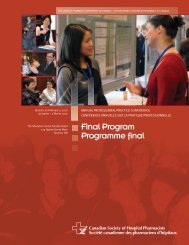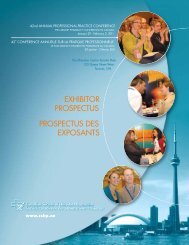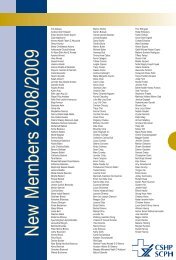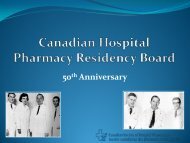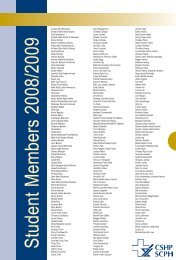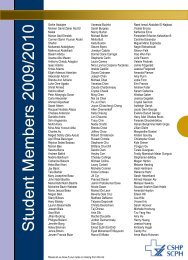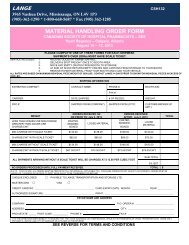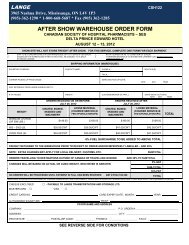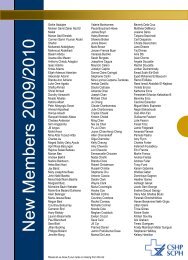Drug Information & Critical Appraisal Workshop: - Canadian Society ...
Drug Information & Critical Appraisal Workshop: - Canadian Society ...
Drug Information & Critical Appraisal Workshop: - Canadian Society ...
Create successful ePaper yourself
Turn your PDF publications into a flip-book with our unique Google optimized e-Paper software.
<strong>Drug</strong> <strong>Information</strong> and <strong>Critical</strong><br />
<strong>Appraisal</strong> <strong>Workshop</strong>:<br />
Finding our way around the maze of drug<br />
and medical information. Part I.<br />
Originally presented at William Osler Health System on Jan 21, 2009; updated Sept<br />
12, 2010<br />
Miranda So, B.Sc., BSc.Phm., Pharm.D., RPh.,<br />
Clinical Pharmacy Specialist—Infectious Diseases,<br />
William Osler Health System<br />
1
Learning Objectives<br />
• To gain an overall appreciation of commonly<br />
available drug information resources in hospital<br />
pharmacy practice<br />
• To be familiar with the levels of evidence<br />
described in medical literature<br />
• To apply critical appraisal principles in evaluating<br />
a drug study<br />
2
Outline<br />
Part 1<br />
Part 2<br />
• <strong>Drug</strong> information • Exercise to evaluate a<br />
resources: The Good, drug study<br />
The Bad, The Ugly<br />
(Disclaimer: presenter’s<br />
personal opinion only)<br />
• <strong>Critical</strong> <strong>Appraisal</strong>: the<br />
Quest for Knowledge<br />
• Formulary Submission:<br />
The Essentials<br />
3
Common <strong>Drug</strong> <strong>Information</strong> (DI) Resources<br />
Good<br />
Bad<br />
Ugly<br />
Micromedex<br />
Dosing; indications;<br />
compatibility (Trissel’s);<br />
interactions;<br />
comparison with other<br />
agents; patient<br />
education<br />
Evidence/clinical trials<br />
not most up-to-date;<br />
online only and no<br />
hand-held<br />
Can be difficult to<br />
navigate or to interpret<br />
(e.g. adverse reactions<br />
in form of case reports);<br />
not on portable device<br />
Lexi-comp /e-Lexicomp<br />
Dosing; indications;<br />
compatibility;<br />
interactions; FDA<br />
warning; patient<br />
education; druginteraction<br />
analysis;<br />
easy-to-read lay-out;<br />
print; online and<br />
handheld<br />
Certain data may be<br />
over-simplified<br />
Individual subscription<br />
on handheld device<br />
$$$<br />
CPS (and e-CPS)<br />
Detailed product<br />
monograph provided by<br />
manufacturers (mfr) with<br />
some exceptions;<br />
<strong>Canadian</strong> warnings<br />
highlighted<br />
Detailed product<br />
monograph provided by<br />
mfr; difficult to interpret<br />
Search by brand-name<br />
(though mildly improved<br />
with e-CPS which allows<br />
generic & brand); nohandheld<br />
4
Common DI Resources<br />
Up-to-date MD Consult Ovid/MEDLINE<br />
Good<br />
Easy to find information on<br />
pathophysiology, diseases;<br />
short and snappy overview<br />
of guidelines, patient<br />
education; helpful for<br />
practising pharmacists<br />
Access to primary (original<br />
research) and secondary<br />
literature (review articles)<br />
with little search terms<br />
restrictions unlike Ovid; e-<br />
books; patient education;<br />
alternative to Ovid<br />
MEDLINE<br />
Systematic way to<br />
search for information;<br />
Boolean logic operators<br />
and Medical Subject<br />
Heading search terms<br />
used<br />
Bad<br />
Not in-depth and can be<br />
MD-oriented; clinical trials<br />
cited may not be “hot off<br />
the press” (depends on<br />
when material was<br />
reviewed)<br />
Can be difficult to find<br />
specific information<br />
Can be difficult to know<br />
what search terms to<br />
use<br />
Ugly<br />
Silver-platter format does<br />
not stimulate critical<br />
thinking in learners (e.g.<br />
pharmacy students)<br />
Can be difficult to find<br />
specific information<br />
Can be labour-intensive<br />
to look through the list,<br />
but can be overcome<br />
with assigning “limits” 5
Common DI Resources (cont’d)<br />
Ottawa IV Manual King Guide Trissel’s<br />
Good<br />
Easy and concise<br />
information on<br />
administration,<br />
dosing, compatibility;<br />
<strong>Canadian</strong> content.<br />
Text and CD formats;<br />
updated annually<br />
Text is updated<br />
quarterly; simple to<br />
read; may be<br />
accessed online<br />
through e-Lexi-comp<br />
subscription<br />
Easy to read; specific<br />
topics such as<br />
calcium/phosphate<br />
concentration in TPN<br />
Bad<br />
Text in loose-leaf<br />
format—individual<br />
pages may be lost<br />
Text subscription and<br />
updates in loose-leaf<br />
format; labour<br />
intensive to maintain<br />
(may be lost easily)<br />
Institutions that only<br />
have access to text<br />
will be required to<br />
purchase a new<br />
edition every couple<br />
of years<br />
Ugly -- How to apply their information to the clinical<br />
situation at hand (e.g. US TPN formulations vs.<br />
formulations available in Canada or accessible<br />
to our institution) 6
Other DI Resources<br />
• Regional DI centres (require membership at<br />
personal or institutional level) and their<br />
communications (e.g. newsletters)<br />
• Institution-specific information on “intranet”, e.g.<br />
formulary, IV monographs<br />
• Health Canada Advisories<br />
• Institute of Safe Medication Practice (ISMP) and<br />
ISMP Canada bulletins<br />
• University libraries (if affiliated)<br />
7
<strong>Critical</strong> <strong>Appraisal</strong><br />
• Why?<br />
• To practise evidence-based medicine (EBM)<br />
requires pharmacists to distinguish high quality<br />
drug information from those of lesser quality<br />
• To facilitate knowledge translation<br />
• To provide unbiased drug information to other<br />
healthcare professionals and patients<br />
8
<strong>Critical</strong> <strong>Appraisal</strong> Tools<br />
• Scoring or criteria: e.g. Jadad scale (e.g. used in<br />
meta-analyses to determine whether a trial should be<br />
included)<br />
• Website example:<br />
o<br />
www.equator-network.org<br />
• “Worksheet to evaluate drug studies” from<br />
Pharmacist’s Letter<br />
• JAMA’s Users’ Guide Series<br />
• CONSORT statements for RCTs www.consortstatement.org<br />
• PRISMA (formerly QUORUM) checklist for<br />
meta-analyses of RCTs<br />
• BMJ checklists<br />
http://resources.bmj.com/bmj/reviewers/peer-reviewersguidance<br />
9
Levels of evidence<br />
In order of highest to lowest evidence<br />
• Systematic review/ meta-analysis of<br />
randomized controlled trial (RCT)*quality limited<br />
by quality of original data<br />
• Randomized controlled trial<br />
• Cross-over study<br />
• Cohort study<br />
• Case-control study<br />
• Analysis of database<br />
• Case series<br />
• Case reports<br />
10
Specific study design:<br />
• Systematic review vs. meta-analysis<br />
o<br />
Meta-analysis uses statistical techniques to integrate<br />
the results of the included studies; increases sample<br />
size and power to detect differences between groups<br />
• Non-inferiority design<br />
o<br />
o<br />
o<br />
One treatment “not worse” than another by a prespecified<br />
margin (Δ) chosen based on statistical<br />
reasoning and clinical judgement<br />
When evaluating, consider: choice of comparing<br />
agent; size of Δ—”is it meaningful?”<br />
Δ should be smaller than the lower 95% CI for the<br />
absolute risk difference observed between standard<br />
therapy and placebo in the relevant superiority trial<br />
Pater C., Current Controlled Trials in Cardiovascular Medicine 2004, 5:8<br />
Piaggio G et al. JAMA 2006;295: 1152<br />
11
Level of evidence often described in<br />
guidelines<br />
Quality of Evidence:<br />
• I. from ≥1 properly<br />
designed RCT<br />
• II. from well designed<br />
controlled, nonrandomized<br />
trials<br />
• III. From well designed<br />
cohort or case-cohort<br />
studies<br />
• IV. From multiple case<br />
series<br />
• V. Opinion of authorities<br />
Quality of<br />
Recommendations<br />
• Good evidence to support<br />
• Fair evidence to support<br />
• Poor evidence, but other<br />
grounds used to make<br />
recommendations<br />
• Fair evidence to exclude<br />
• Good evidence to<br />
exclude<br />
12
Determining the quality of evidence<br />
Underlying methodology<br />
A. RCT<br />
B. Downgraded RCT or upgraded observational<br />
studies<br />
C. Well-done observational studies<br />
D. Case series or expert opinion<br />
Dellinger et al. Crit Care Med. 2008; 36:296<br />
Atkins et al for the GRADE Working Group. BMJ 2004;328:1490.<br />
Guyatt et al. BMJ 2008;336:995.<br />
13
Determining the quality of evidence<br />
Factors that might decrease<br />
strength of evidence<br />
• Poor quality of planning &<br />
implementation of available of<br />
RCTs suggest high<br />
likelihood of bias<br />
• Inconsistency of results<br />
• Indirectness of evidence<br />
• Imprecision of results<br />
• High likelihood of reporting/<br />
publication bias<br />
Main factors that may increase<br />
strength of evidence<br />
• Large magnitude of effect<br />
[direct evidence; relative risk<br />
(RR)>2 with no confounders]<br />
• V. large magnitude of effect<br />
(RR>5 with no threats to<br />
validity)<br />
• Dose-response gradient<br />
Dellinger et al. Crit Care Med. 2008; 36:296<br />
Atkins et al for the GRADE Working Group. BMJ 2004;328:1490.<br />
Guyatt et al. BMJ 2008;336:995.<br />
14
Evaluating Clinical Studies<br />
• Validity: rooted in study design<br />
• Control confounding factors that may bias estimate<br />
of treatment effect<br />
• RCT evidence (generally) stronger than that of<br />
observational studies<br />
• Rigorous observational studies stronger than uncontrolled<br />
case series<br />
• Common themes to consider:<br />
• Difference between study groups at baseline<br />
• Allocation concealment<br />
• Blinding<br />
• Losses to follow up<br />
• Intention-to-treat analysis<br />
• Stopping early for benefit<br />
Atkins et al for the GRADE Working Group. BMJ<br />
2004;328:1490.<br />
• Failure to report outcomes Guyatt et al. BMJ 2008;336:995. 15
Evaluating Clinical Studies: Common themes to<br />
consider<br />
• Clinically significant vs. statistically significant<br />
results<br />
• Consistency of results (compared to similar<br />
studies)<br />
• A priori vs. post-hoc analyses<br />
• Safety: benefit vs. harm (can be<br />
overlooked...especially if trial stopped early for<br />
benefit)<br />
• Conclusion consistent with results<br />
• Application to your patient<br />
Atkins et al for the GRADE Working Group. BMJ 2004;328:1490.<br />
Guyatt et al. BMJ 2008;336:995.<br />
16
Formulary submission: the Essentials<br />
• Evidence-based—apply your skills of critical<br />
appraisal<br />
• Acknowledge limitations of studies coming<br />
from manufacturer’s formulary submission<br />
package<br />
• Find the strongest evidence to support your<br />
submission<br />
• Applicability of evidenceusage criteria<br />
• PEcon analysisimpact on the patient, the<br />
hospital, the systemresources:<br />
http://resources.bmj.com/bmj/authors/checkli<br />
sts-forms/health-economics<br />
http://cadth.ca/index.php/en/home<br />
17
Part 2 of <strong>Workshop</strong><br />
• To prepare for Part 2, please read this article:<br />
Gardiner D et al. Safety and Efficacy of<br />
Intravenous Tigecycline in Subjects with<br />
Secondary Bacteremia: Pooled Results from 8<br />
Phase III Clinical Trials. Clin Infect Dis.<br />
2010;50:229-38.<br />
Go through a critical appraisal exercise in Part<br />
2 of the presentation<br />
18



